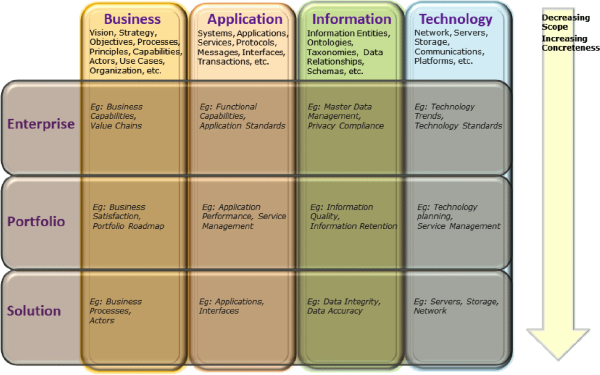Sidebar: Architecture and Strategic Alignment
Whose role is it to ensure strategic alignment? Architecture. For clarification, when I say "Architecture," I am referring to its modern best practice, which means that Architecture is a Practice that holistically encompasses Business, Application, Information, and Technology domains (Security being a view that cross-cuts those domains) and is applied contextually at the Enterprise, the Portfolio/Segment, and the Solution/Project layers of the organization. Visualize a grid, with columns named Business, Application, Information, and Technology, and rows named Enterprise, Portfolio, and Solution. As you move down rows, the architecture process deals with more-specific/concrete and more-focused concerns; for example: capabilities at the enterprise level, but systems at the solution level; value chains at the enterprise level, but processes at the solution level. Enterprise, Portfolio, and Solution Architects work intimately together as a team that provides seamless stewardship of strategy, from high-level executive goals right down to projects that deliver on those goals. Very briefly, here's how they achieve that seamless continuity:
The Enterprise Architect works with executive and senior Management to assist them in structuring their strategic objectives into robust and executable strategy, tying in and accounting for relevant success influences such as industry and technology trends, best practices, organizational current state, and the strategies of their business peers across the enterprise.
The Enterprise Architect shares and socializes the enterprise strategies, roadmaps, and priorities with the Portfolio Architect, who takes this context into account when supporting portfolio-level Management to drive out their portfolio strategies and roadmaps. Conversely, the Portfolio Architect socializes the strategies, roadmaps, and priorities of the portfolio with the Enterprise Architect, for their awareness when supporting senior Management in strategic decision-making.
The Portfolio Architect shares and socializes the portfolio strategies, roadmaps, and priorities with the Solution Architect, who takes this context into account when creating solution designs and when providing architectural oversight for the product development. Conversely, the Solution Architect socializes learnings from the project (product development) with the Portfolio Architect, for their awareness when supporting portfolio-level Management in strategic decision-making.
In a larger company, you may have a dedicated individual as, for example, an Enterprise Business Architect or a Portfolio Information Architect — even multiple individuals in each of those roles. In a smaller company, you will likely have a single individual who may cover multiple architecture domains (the columns) and perhaps multiple levels as well (the rows). Regardless of the number of Architects or how narrow a specialist they may be, it is critical that the team is tightly integrated and cohesive (unified) so that the architecture practice and architecture processes are also integrated and cohesive (and therefore, effective).
